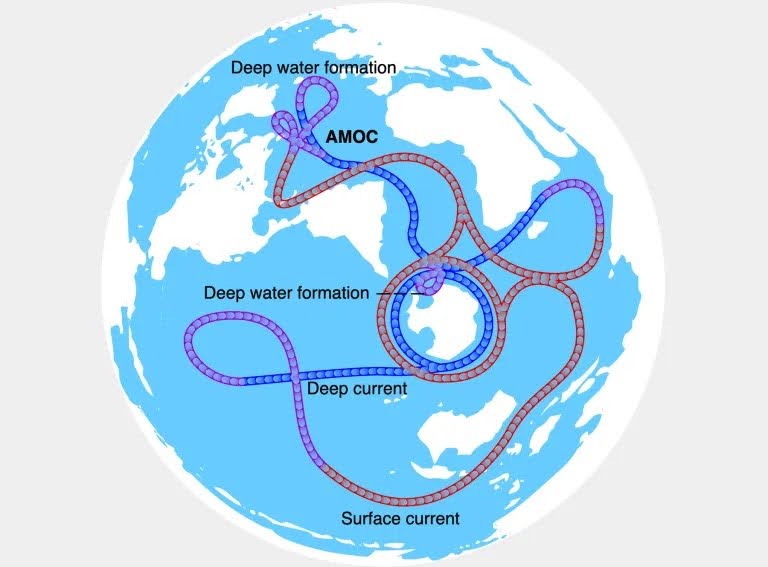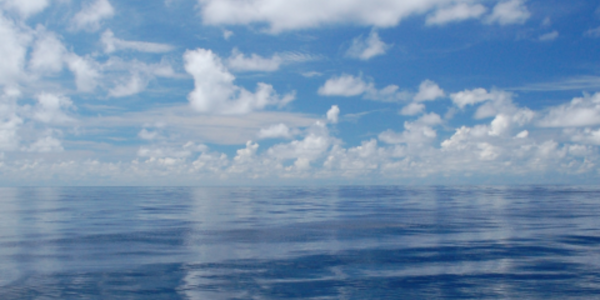Scientists Publish Evidence of Slowing Atlantic Meridional Overturning Circulation (AMOC)

The world’s ocean is constantly moving. Ocean currents (movement of water from one location to another) are easier to see closer to shore, but currents are found from the ocean's surface down to the seafloor. The Atlantic Meridional Overturning Circulation (AMOC) is one of the most prominent and powerful surface-to-deep currents. AMOC is a system of ocean currents that circulates water within the Atlantic Ocean, bringing warm water north and cold water south.
There has been concern in the scientific community that the AMOC is slowing down. Most climate scientists believe that a substantial weakening of AMOC might result in significant, possibly catastrophic, climate change. A weaker AMOC would decrease the mixing and bring less warm water northwards, leaving warmth to the tropics and cold to the polar areas—likely making hot areas hotter and cold areas colder. This AMOC decline could also affect precipitation patterns, strengthen storms, and raise sea level along the North American Atlantic coast.
Since AMOC plays an important role in sustaining the equilibrium of Earth’s climate system, understanding the transport of water in this system is vital. Using over 60 years of continuous oceanic records, NCEI and University of Maryland (UMD) scientists recently published a study in Frontiers in Marine Science that sheds light on the health of this critical oceanic element of the climate system. This culminating publication revises a long-term research effort that began by first studying the heat content evolution of the North Atlantic and then continued focusing on the critical parts of AMOC—the Gulf Stream system, the Northwest Atlantic, and the Atlantic Slope Water and the Gulf of Maine.
Exploring the AMOC
Currents are driven by wind and density gradients. Since density is a function of the temperature and salinity of seawater, the density-driven ocean currents system is known as thermohaline ocean circulation. Cold, salty water is dense and sinks to the bottom of the ocean, while the less dense, warm water remains in the upper layers. These deep-ocean currents continuously carry dense ocean waters in what is known as the global ocean conveyor belt, of which the AMOC is a vital part. The global ocean conveyor belt ensures that heat and energy are distributed around the earth, contributing to world climate conditions.
AMOC circulates water within the Atlantic Ocean, bringing warm water north and cold water south. The AMOC includes the Gulf Stream, which flows along the east coast of North America, carrying warm water from the Florida Straits to the Grand Banks off Newfoundland, and the North Atlantic Current, which flows across the ocean toward Europe. When the warm water carried by the Gulf Stream and North Atlantic Current reaches subpolar regions (near Greenland or Arctica), it loses heat to the atmosphere and becomes colder and more dense. The waters then sink to depth and return south, creating a vertical “overturning” circulation throughout the ocean basin distinct from the horizontal movement of upper ocean currents.

Quality Controlled Data
The world ocean’s surface has been heating up for decades; therefore, concerns about the future of the AMOC are warranted. NCEI scientists set out to understand the past trends in the ocean to help predict the system's future.
Because of the process of thermohaline circulation, the scientists reviewed in situ (on-site within the ocean, as opposed to remotely-sensed, such as satellite data) temperature, salinity, and density data measured in the North Atlantic. The scientists used decadal data averages, or climatologies, of the seawater temperature and salinity from 1955-1964 to 2005-2017 from NCEI’s World Ocean Atlas and sea surface height data from the University of Maryland’s SODA reanalysis for the most recent decades of 1980-2019. The World Ocean Atlas (WOA) is a collection of objectively analyzed, quality-controlled temperature, salinity, oxygen, phosphate, silicate, and nitrate means based on the World Ocean Database (WOD) profile data. The WOD is the world's largest collection of uniformly formatted, quality-controlled, publicly available ocean profile data. The data, archived by NCEI, maintains records of temperature, salinity, nutrients, plankton, pH, oxygen data, and several other ocean variables.
As the quality and quantity of the in situ temperature and salinity data have dramatically improved over the past 60-plus years, detailed mapping of certain ocean regions that have a large volume of observations became possible through a new NCEI Regional Ocean Climatology (RC) project. RCs provide high-resolution local temperature and salinity climatologies with horizontal resolution as fine as ~10 km, which is equal to 0.1° in latitude and longitude. Of all RCs compiled at NCEI in recent years, the Northwest Atlantic Regional Climatology is the most advanced; it was first presented in the Bulletin of the American Meteorological Society in 2018 and demonstrated the decadal changes of the Gulf Stream system superimposed on the seasonal and mesoscale variability.
Overall, WOD, which is used to derive the WOA and RC products, has supplied over 60 years of continuous, quality-controlled oceanic data collected in the North Atlantic Ocean and provided new information about the long-term variations in the AMOC.
Changing But Resilient
The analyses of WOD data in the above-mentioned publications show that the entire North Atlantic is systematically warming. Moreover, the thermohaline circulation slowed down everywhere in the North Atlantic lately. The NCEI and UMD scientists found that AMOC remained stable and consistent from 1955 to 1994 but declined in strength and speed in the last two decades. They attribute this slowdown to the continued warming of the ocean surface and the accompanying changes in the salinity of the ocean's upper layers.
Despite the recent AMOC slowdown, the paper concludes that the system is showing signs of resilience, mostly due to the robustness of the Gulf Stream. The Gulf Stream resilience is in keeping with a study published by NCEI researchers in 2019.
________
Citation: Mishonov A, Seidov D and Reagan J (2024) Revisiting the multidecadal variability of North Atlantic Ocean circulation and climate. Front. Mar. Sci. 11:1345426. doi: 10.3389/fmars.2024.1345426



